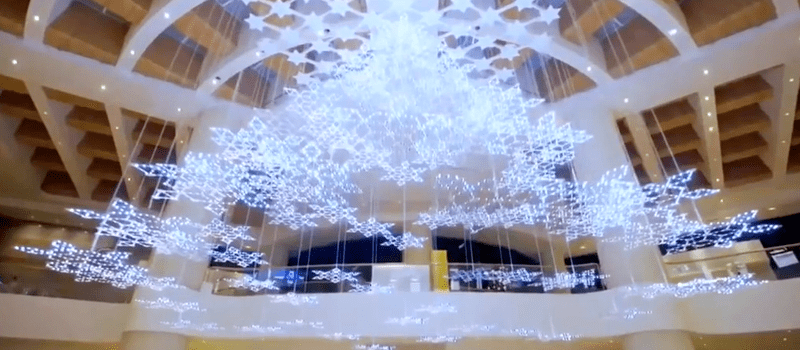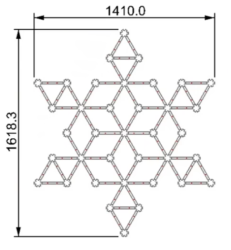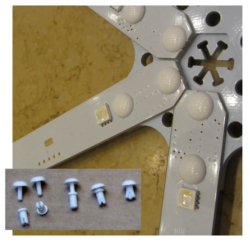[Mike Harrison] talked about designing and building a huge scale LED lighting installation in which PCBs were used as both electrical and mechanical elements, and presented at Electromagnetic Field 2016. The project involved 84,000 RGBW LEDs, 14,000 microcontrollers and 25,000 PCBs. It had some different problems to solve compared to small jobs, but [Mike] shared techniques that could be equally applied to smaller scale projects or applications. He goes into detail on designing for manufacture and assembly, sourcing the parts, and building the units on-site.
 The installation itself was a snowflake display for a high-end shopping mall in Hong Kong in the 2015 Christmas season. [Mike] wanted a small number of modular boards that could be connected together on-site to make up the right shapes. In an effort to minimize the kinds of manufacturing and parts needed, he ended up using modular white PCBs as structural elements as well as electrical. With the exception of some minor hardware like steel wire supports, no part of the huge snowflakes required anything outside of usual PCB manufacturing processes to make. The fewer suppliers, the fewer potential problems. [Mike] goes into design detail at 6:28 in the video.
The installation itself was a snowflake display for a high-end shopping mall in Hong Kong in the 2015 Christmas season. [Mike] wanted a small number of modular boards that could be connected together on-site to make up the right shapes. In an effort to minimize the kinds of manufacturing and parts needed, he ended up using modular white PCBs as structural elements as well as electrical. With the exception of some minor hardware like steel wire supports, no part of the huge snowflakes required anything outside of usual PCB manufacturing processes to make. The fewer suppliers, the fewer potential problems. [Mike] goes into design detail at 6:28 in the video.
For the connections between the boards, he ended up using SIM card connectors intended for cell phones. Some testing led to choosing a connector that matched up well with the thickness of a 1.6mm PCB used as a spacer. About 28,000 of them were used, and for a while in 2015 it was very hard to get a hold of that particular part, because they had cleaned everyone out!
About half-way through the video (10:55) [Mike] goes into microcontroller and firmware details. The PIC12F1501 turned out to be a great fit for reasons that included cost, wide operating voltage range, 10-bit PWM for each of Red, Green, Blue, and White, and the low cost of having Microchip program the firmware in at the factory. RGBW LEDs were chosen for a number of reasons, but mainly because the white generated is much more visually consistent across a large display (compared to lighting each of the RGB elements to make white.) He made sure that it was easy to reprogram the firmware across all units easily if needed, because updating thousands of microcontrollers one at a time is just not an option.
Video of the presentation is embedded below, but if you want to go straight to some video of the finished installation, it starts at 21:38.
Using PCB material as a structural component has a lot of potential. We’ve seen it in this clever tiny 7-segment display, and more recently in PocketNC’s FR4 Machine Shield. If you’re interested in trying it yourself, you can learn all about the finer points of how to use FR4 for enclosures.



















Very great!!!
Loverley
Nice design, like the simplicity and redundancy.
Should mention it’s the same Mike from Mikeselectricstuff. Some of the best teardowns eva.
Every time you see a big LED installation you can safely assume it’s the same Mike.
Wonderfull!
I was lucky enough to be able to visit that place and see the installation after seeing a little sneak peek on Mike’s channel.
Dis good, needs small upgrade, parallelas or something, with ring/bus style fast network, passthrough, neural connections, self assembling, in shell around planet, all satellite and interweb functions uploaded, solar panels on back, beam down free powers as well as free interwebs and phone… delegate important decisions, like which city has been bad enough it deserves burden of olympic games.
Rrrrriiiiiight….I’ll get right on that for ya.
Looks great but seriously – a video of a screen grab of a video playing the the original video! Makes me feel sick just to watch part of it. It’s like emulating an intel quad code on a ATmega328.
Written in BASIC, where the BASIC interpreter is written in Java…
Winter is coming.
Oh crap sorry, made a mess opening the milk in the break room, forgot to mop it up.
Totally unrelated to the post topic.
I have seen a robot that was built in part with a folded pcb. It was epfl’s Alice II.
[img]http://disal.epfl.ch/files/content/sites/disal2/files/Images/alice-II_web.png[/img]
https://web.archive.org/web/20101116200957/http://asl.epfl.ch/index.html?content=research/systems/Alice/alice.php
Finished installation on mikeselectricstuff channel:
https://www.youtube.com/watch?v=HqpOEBFzr0k
https://www.youtube.com/watch?v=Jg2wulI_POE
Fascinating, the constraint of building the thing mostly from PCBs has turned up some unique problem solving, but throughout the whole video I had this weird feeling I’ve heard that voice before…
Then I got it, Mike Harrison sounds almost exactly like the oddball comedian Joe Wilkinson. Search for him on YouTube :)
So what was the error in the slides? Was not able to spot it…
I think it’s where it says “16uS for 125kbit” above the serial diagram… it should be 8uS.